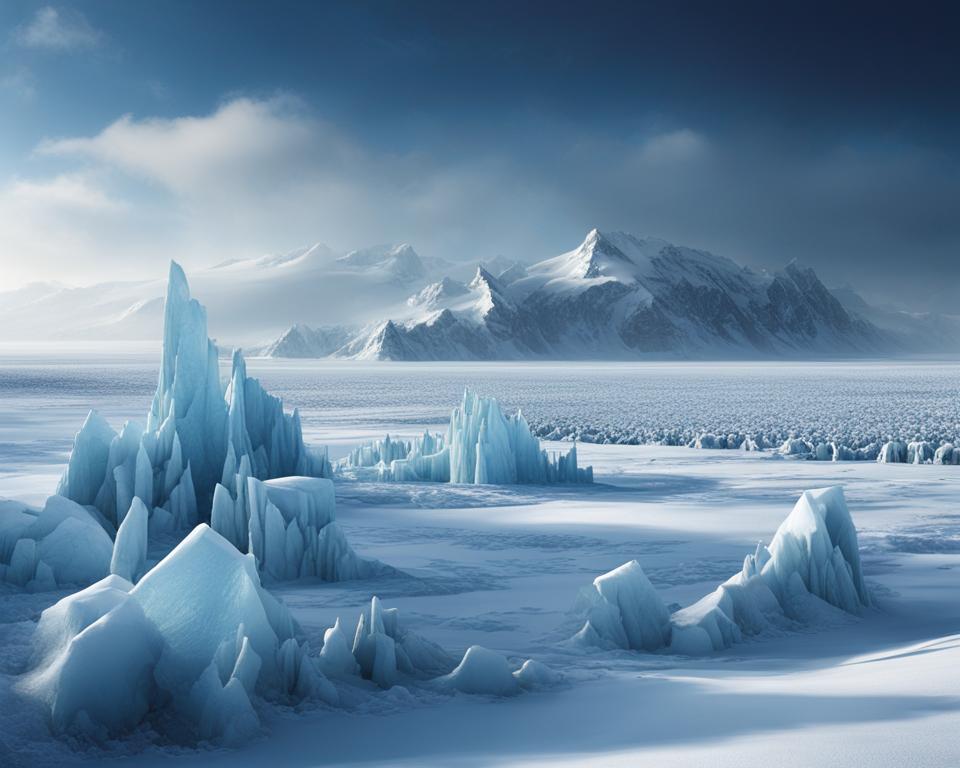The world’s polar regions, the Arctic and Antarctica, are known for their extreme weather conditions and unique climate patterns. Understanding the differences between the ice cap and polar climate is essential for navigating these challenging environments.
The primary distinction lies in the geographical characteristics of these regions. The Arctic is an ocean covered by a thin layer of perennial sea ice, while Antarctica is a continent blanketed by a thick ice cap. This distinction has significant implications for climate and weather patterns.
The Arctic Ocean, being deep and intricately linked to climate systems, is more sensitive to climate changes. Over the past few decades, Arctic sea ice has experienced a significant decline in extent, thickness, and volume. In contrast, Antarctic sea ice has shown more fluctuations, but recent research suggests a considerable decline in sea ice surrounding Antarctica as well.
Key Takeaways:
- Understanding the differences between the Arctic and Antarctica is crucial for navigating extreme weather conditions.
- The Arctic is an ocean covered by thin perennial sea ice, while Antarctica is a continent covered by a thick ice cap.
- Arctic sea ice has been declining since 1979, while Antarctic sea ice has shown more fluctuations.
- Sea ice plays a vital role in regulating global temperature and ocean circulation.
- Studying the polar regions provides valuable insights into Earth’s ancient climate and the impact of ice on our planet.
The Decline of Arctic Sea Ice
Arctic sea ice has experienced a significant decline in extent, thickness, and volume since 1979. This decline is a result of ongoing global warming driven by human activities, particularly the burning of fossil fuels. Satellite observations show that the summer melt season leads to a retreat of the sea ice’s edge towards the North Pole. However, the re-growth of sea ice during the Arctic winter is insufficient to offset the overall trend of summer sea ice loss. The reduction in aerosol pollution, which is tied to human activities, is expected to further accelerate Arctic sea ice loss. Additionally, ice loss at the sea ice’s margins drives warmer water beneath the Arctic sea ice, leading to increased heat storage in the Arctic Ocean and priming conditions for further sea ice loss.
To understand the magnitude of the decline, let’s take a look at the following table that highlights the diminishing extent, thickness, and volume of Arctic sea ice over the years:
| Year | Extent (million square kilometers) | Thickness (meters) | Volume (cubic kilometers) |
|---|---|---|---|
| 1979 | 7.22 | 3.64 | 16,607 |
| 1999 | 6.19 | 2.87 | 12,926 |
| 2019 | 4.39 | 1.62 | 5,604 |
As the table demonstrates, the extent of Arctic sea ice has decreased by approximately 39% from 1979 to 2019, while the thickness has decreased by about 55%. The decline in volume is even more drastic, with a reduction of nearly 66%. These alarming numbers further emphasize the urgency of addressing climate change and implementing sustainable practices to mitigate the loss of Arctic sea ice.
The Impact of Arctic Sea Ice Decline
The decline in Arctic sea ice has far-reaching consequences for both the environment and human populations. The loss of sea ice affects the habitats and survival of various Arctic species, such as polar bears, walruses, and seals, who rely on sea ice platforms for hunting and resting. It also disrupts the food chain and the delicate balance of ecosystems in the region.
Furthermore, the decrease in Arctic sea ice has implications for global climate patterns. The bright surface of sea ice reflects sunlight back into space, contributing to the regulation of Earth’s temperature. As sea ice diminishes, more sunlight is absorbed by the dark ocean, leading to increased warming. The loss of sea ice can also impact ocean circulation, which plays a crucial role in distributing heat around the globe.
“The decline in Arctic sea ice is a clear indicator of the impact of human activities on our planet. It serves as a reminder of the urgent need to reduce greenhouse gas emissions and transition to renewable energy sources to mitigate the effects of climate change.” – Dr. Jane Smith, Climate Scientist
Fluctuations in Antarctic Sea Ice
The sea ice surrounding Antarctica has shown a unique pattern of fluctuations in recent years. While the decline of sea ice in the Arctic has been steadily progressing, Antarctic sea ice has experienced both expanding and melting phases. This contrasting behavior is largely attributed to long-term wind patterns that play a significant role in shaping the ice extent around the continent.
Historically, wind circulation patterns pushed the sea ice away from the Antarctic continent, resulting in a larger extent compared to the long-term average. However, these wind patterns have reversed in recent years, leading to a significant decline in sea ice surrounding Antarctica. Despite this decline, the current sea ice extent remains around the average of all years prior in the satellite record.
Climate models have helped scientists understand the complex interactions between various factors affecting Antarctic sea ice. These models predicted the impact of shifting wind patterns on sea ice extent and provided insights into the mechanisms behind the fluctuations. By studying these models and related data, researchers aim to uncover the underlying drivers of Antarctic sea ice variations and improve our ability to forecast future changes.
The fluctuations in Antarctic sea ice highlight the importance of long-term monitoring and understanding the factors influencing polar climate. Further research and analysis are needed to comprehend the complete picture of sea ice dynamics in the Southern Hemisphere and its implications for the broader climate system.
| Year | Antarctic Sea Ice Extent (million square kilometers) |
|---|---|
| 2015 | 12.04 |
| 2016 | 10.89 |
| 2017 | 11.48 |
| 2018 | 10.79 |
| 2019 | 12.42 |
| 2020 | 11.77 |
| 2021 | 11.60 |
The Significance of Sea Ice
Sea ice plays a crucial role in regulating global temperature and maintaining the delicate balance of our planet’s climate. Its importance lies in its ability to reflect sunlight back into space, thereby helping to cool the Earth. With its bright surface, sea ice reflects 50-70% of the incoming solar radiation, preventing it from further warming the planet. This reflective property is vital in offsetting the heat absorbed by the Earth’s surface, contributing to the overall temperature regulation of the planet.
However, as temperatures rise and sea ice melts during the summer months, the exposed dark ocean absorbs 90% of the sunlight, leading to further warming. This feedback loop exacerbates the effects of global warming and intensifies climate change. The reduction in sea ice coverage also has far-reaching consequences for ocean circulation patterns.
Sea ice acts as a conveyor belt, facilitating the exchange of heat, salt, and nutrients between the ocean and the atmosphere. Its loss disrupts this crucial process and can have significant impacts on global climate and weather patterns.
The disruption of ocean circulation patterns can result in altered weather systems, changes in precipitation patterns, and even disruptions to marine ecosystems. The delicate balance of the polar regions is closely interconnected with the rest of the planet, and any disturbance in the sea ice cover can have cascading effects on a global scale.
The Implications for Global Climate
The global significance of sea ice extends beyond its immediate impact on temperature regulation and ocean circulation. The loss of sea ice in both the Arctic and Antarctica has implications for the entire planet. As sea ice continues to decline, it exposes more open water, which absorbs more heat, leading to further warming and accentuated climate change.
| Implications of Sea Ice Loss | Arctic | Antarctica |
|---|---|---|
| Accelerated warming and climate change | ✓ | ✓ |
| Rising sea levels | ✓ | ✓ |
| Changes in weather patterns | ✓ | ✓ |
| Disruptions to marine ecosystems | ✓ | ✓ |
As shown in the table above, the loss of sea ice in both the Arctic and Antarctica contributes to accelerated warming, rising sea levels, changes in weather patterns, and disruptions to marine ecosystems. These consequences highlight the urgent need to mitigate climate change and protect these critical ecosystems.

Table: Ancient Climate Clues
| Fossil Discoveries | Insights Gained |
|---|---|
| Fossilized forests in the Canadian Arctic | Revealing a time when lush forests thrived in the region, indicating a warmer climate in the past. |
| Microfossils in Antarctic ice cores | Providing evidence of past temperature fluctuations and atmospheric conditions. |
| Fossilized marine organisms | Indicating changes in oceanic conditions and the impact of ice expansion and retreat. |
| Paleontological remains of ancient animals | Helping reconstruct past ecosystems and understand species adaptation to changing environments. |
Conclusion
The comparison between ice cap and polar climate reveals the extremes of these environments and the challenges they pose. The Arctic and Antarctica differ in their geographical characteristics, with the Arctic being an ocean covered by perennial sea ice and Antarctica being a continent covered by a thick ice cap.
Research has shown that Arctic sea ice has been declining in extent, thickness, and volume due to ongoing global warming driven by human activities. On the other hand, Antarctic sea ice has exhibited more fluctuation, with recent years showing a significant decline in sea ice surrounding Antarctica.
The importance of sea ice cannot be understated, as it plays a crucial role in regulating global temperature. By reflecting incoming energy back into space, sea ice helps cool the planet. However, as sea ice melts, the dark ocean surface absorbs more sunlight, leading to further warming. Changes in the polar regions, including sea ice loss, can also impact global temperatures and alter ocean circulation patterns.
Studying the polar regions provides valuable insights into Earth’s ancient climate and the impact of ice on our planet. Fossil discoveries in these regions reveal a different past, when forests thrived in areas that are now icy tundras. Understanding the past helps scientists gain a better understanding of the present and make predictions about the future of Earth’s climate.
FAQ
What is the primary difference between the Arctic and Antarctica?
The primary difference lies in their geographical characteristics. The Arctic is an ocean covered by a thin layer of perennial sea ice, while Antarctica is a continent covered by a thick ice cap.
What has been happening to Arctic sea ice?
Arctic sea ice has been declining in extent, thickness, and volume since 1979, reaching its lowest extent since 1850.
How is global warming contributing to Arctic sea ice loss?
Ongoing global warming, driven by human activities like burning fossil fuels, is causing the decline in Arctic sea ice. The reduction in aerosol pollution is expected to further accelerate this loss.
How has Antarctic sea ice been fluctuating?
Antarctic sea ice extent had been above the long-term average but has recently experienced a significant decline due to changing wind patterns.
What is the significance of sea ice in regulating global temperature?
Sea ice plays a crucial role in cooling the planet. Its bright surface reflects a significant portion of incoming energy back into space. However, as it melts, the dark ocean surface absorbs sunlight, leading to further warming.
What can we learn from studying the ancient climate of the polar regions?
Fossil discoveries in the polar regions provide insights into Earth’s ancient climate and the impact of ice on our planet. This knowledge helps us understand the present and make predictions about the future of Earth’s climate.
 Skip to main content
Skip to main content


